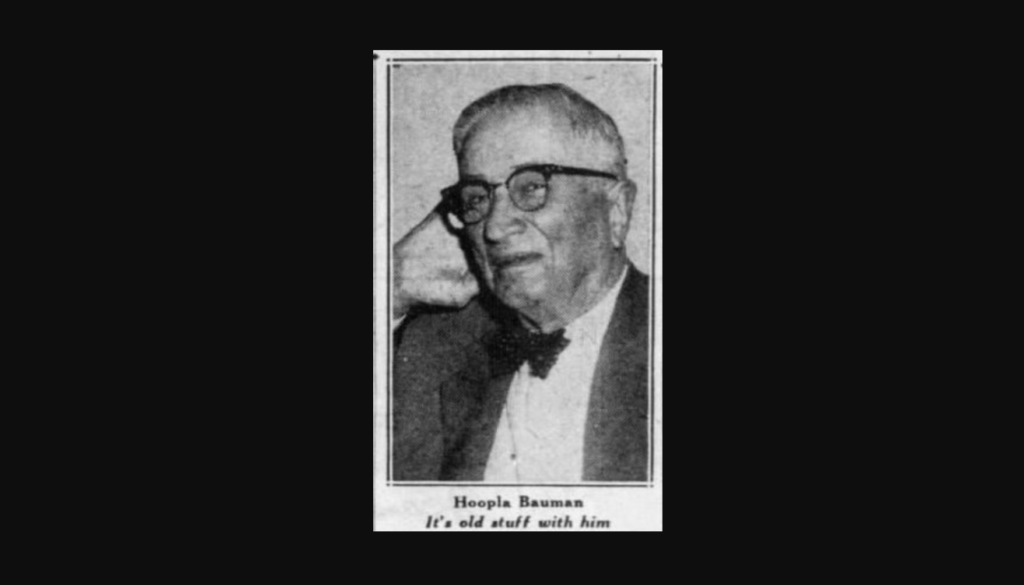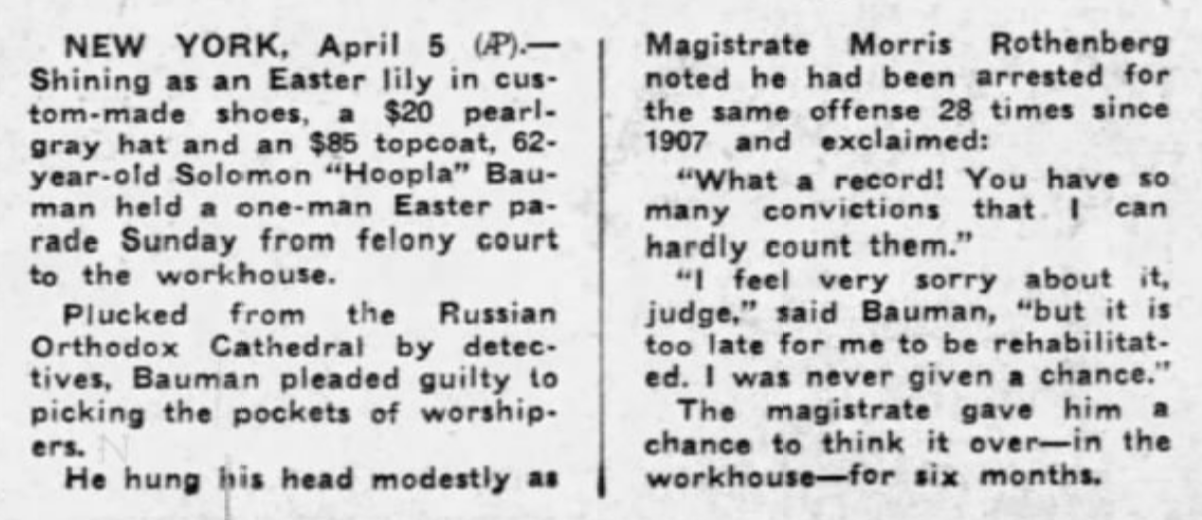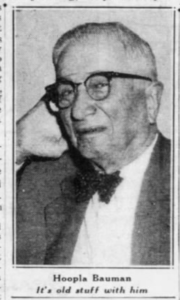Meet the Gentleman Pickpocket Who Became an Early Media Meme
During the first half of the 20th century, the New York City press could not get enough of Hoopla Bauman.

I know that Hoopla Bauman’s first arrest for pickpocketing was on February 11th, 1907, because a reporter from the New York Daily News knew the date. I like to imagine he had it circled in red ink on his calendar. The date is cited in a 1957 article, which announces: “Old Hoopla Bauman, who last Feb. 11 celebrated his golden jubilee as a thief, went back to jail yesterday for ‘jostling,’ a police euphemism for picking pockets.” At the time, Bauman was seventy-eight years old.
I didn’t really grasp how last century’s newspapers were different from what we read today until I discovered New York City media’s thirty-year obsession with Solomon “Hoopla” Bauman, the gentleman pickpocket of the Upper West Side. Hoopla Bauman stories are manifold, appeared in several major New York newspapers, and share a set format. They include a head-to-toe description of his outfit: for example, the Daily News writes that “It was no trick to recognize old Hoopla…for he is a walking advertisement for the very best haberdasheries. He was turned out in a well-pressed blue suit, a sparkling white shirt, a blue polka dot bow tie, and glittering black shoes.”
The articles also include a running tally of his previous arrests—in 1957, he’d been nabbed forty-four times—and often quote the insults he directs at the arresting officers. In the Daily News article, Hoopla jabs: “Look at your clothes! You look like a bunch of bums. I paid $50 for these shoes I’m wearing and that’s more than all your rags put together.”
When a detective named James O’Dea responds that cops can’t afford to dress like Hoopla on a government salary, Hoopla retorts: “Why don’t you guys go out and get a job and quit being parasites? Always picking on me instead of working for a living!” We also learn the penalty: Hoopla is sentenced to six months in jail.
The first mention of Solomon “Hoopla” Bauman in the New York press comes in 1924, when the Brooklyn Daily Eagle reports that he stole $75 from a victim in Kip’s Bay. In court, his lawyer explains that Bauman is British, the son of an “English peer of means” who paid him £50,000 to leave the country. This Dickensian origin story is never mentioned again. Perhaps this was an elaborate prank cooked up with his lawyer: huddled in a smoke-filled room, they sketched out a first draft of the character who would become Hoopla Bauman, fancy pickpocket, and the disgraced nobleman backstory was a flourish that was later discarded.
Throughout the ’20s and the Great Depression, Bauman returns, again and again, to target sophisticated crowds. He pinches some money from a man on his way home from the Brooklyn Academy of Music. He appears at a forum held a literary New York newspaper, a story headlined “Pickpocket Picks Up Culture on His Rounds.” He attends a speech by Albert Einstein. Bauman is detained—the incident appears in a footnote in an article on the event itself, published in a Wisconsin newspaper—even though he hadn’t stolen anything, and allegedly bemoans the fact that the theory-of-relativity crowd wasn’t carrying much cash.

A few years later, when he is caught stealing from the parishioners at a Russian Orthodox cathedral, Bauman is described as “shining like an Easter lily in custom-made shoes, a $20 pearl-gray hat and an $85 topcoat.” It was his twenty-eighth arrest, and he’s sent to jail for six months. In court, he apologizes: “I feel very sorry about it, judge. But it is too late for me to be rehabilitated,” an argument that proves ineffective.
A decade later, we see Hoopla with “his chin tucked disconsolately into his silk muffler [walking] sadly out of Mid-Manhattan Court.” He had, allegedly, been picking pockets at the Metropolitan Opera House. A detective named Joseph Maloney says that he was dressed like a “man-about town,” in a beautiful tan overcoat—beautiful is the detective’s word—a scarf, gloves, and a homburg, the type of hat Michael Corleone wears in The Godfather. It was his fortieth arrest.
The wall-to-wall coverage of the exploits of a petty criminal whose reported paydays top out around $75 is somewhat baffling. Perhaps this was fueled by an archetype — well-dressed pickpockets who hate cops — that has since faded from cultural consciousness. It’s more likely that Hoopla Bauman stories are the product of the sheer force of his persona and an instinct for turning himself into news; the level of detail in the stories reflects something of a symbiotic relationship between a charismatic antagonist and a 20th-century press looking for characters.
The great victory of Hoopla Bauman’s life is that he never stopped picking pockets, and the police did not seem especially invested in preventing him from doing so. Early in his career, he was threatened with 15 years to life in prison under a mandatory minimums law, but a judge waived the charge: he said that his conscience wouldn’t allow him to hand down a sentence that harsh, and that it wouldn’t serve society. Bauman went on doing petty theft, serving a few months in jail, and rattling off one-liners to crime reporters at the Daily News and the Brooklyn Daily Eagle, again and again, for the next twenty years.

I can only find one image of Bauman: a small portrait that ran alongside the Daily News report, the article where Hoopla says the cops’ outfits are trash. It appears to be a mug shot—taken against a blank backdrop, with sharp shadows that indicate a flash bulb—but it doesn’t feel like one. Bauman’s light hair is neatly combed back. He’s wearing horn-rimmed glasses and a bow tie. One hand rests just behind his cheek, like he’s posing. “Here I am,” he seems to say. His smile is elusive. “I am Hoopla Bauman, the descendant of lords. I am here to pick pockets.”
Subscribe to Study Hall for Opportunity, knowledge, and community
$532.50 is the average payment via the Study Hall marketplace, where freelance opportunities from top publications are posted. Members also get access to a media digest newsletter, community networking spaces, paywalled content about the media industry from a worker's perspective, and a database of 1000 commissioning editor contacts at publications around the world. Click here to learn more.
